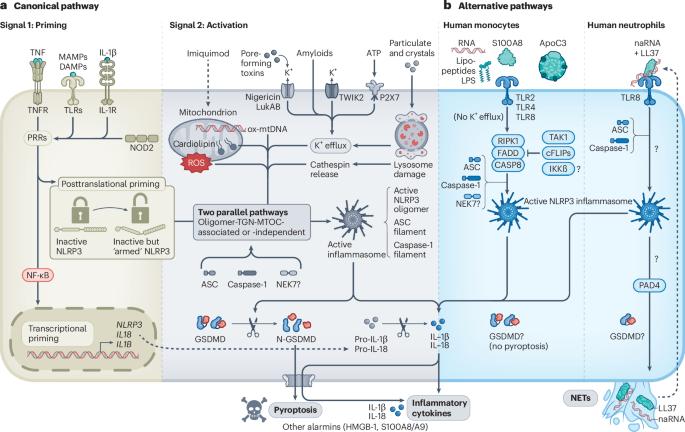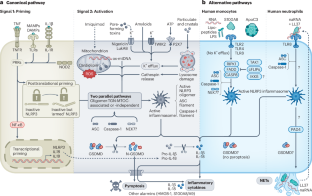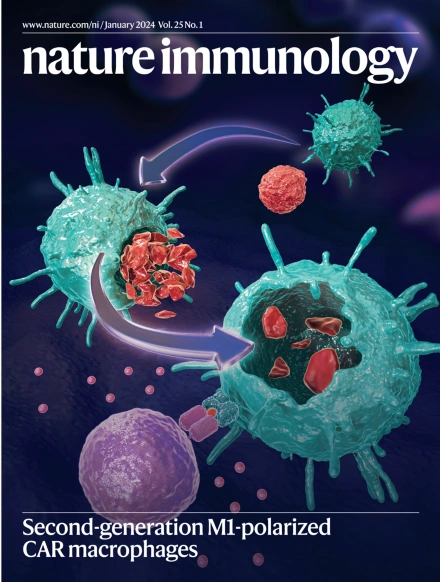The expanding role of the NLRP3 inflammasome from periodic fevers to therapeutic targets
IF 27.6
1区 医学
Q1 IMMUNOLOGY
引用次数: 0
Abstract
Understanding and treating inflammation has proven a formidable challenge. The initiator and central motor of inflammation, the protein NLRP3, is an innate immune sentinel and nonspecific sensor of cellular perturbation. A wide array of inflammatory triggers prompts the formation of an NLRP3 ‘inflammasome’ complex, leading to inflammatory interleukin-1 family cytokine release and pyroptotic cell death. Since gain-of-function mutations in NLRP3 were demonstrated to cause a rare autoinflammatory disease termed cryopyrin-associated periodic syndrome, NLRP3 has emerged as key mediator of inflammation in mouse models for many common diseases, including atherosclerosis, Alzheimer’s disease and gout. But even though small-molecule NLRP3 modulators have entered clinical development, many aspects of NLRP3 activation and regulation in humans remain relatively unclear. This Review summarizes the current understanding of the molecular mechanisms that drive NLRP3 inflammasome activation and regulation, and discusses emerging targeting strategies. Understanding these processes can guide precision medicine approaches aimed at mitigating NLRP3-driven pathologies. Latz et al. review the molecular mechanisms that drive NLRP3 inflammasome activation and regulation, and discuss emerging targeting strategies.


NLRP3炎性体的作用从周期性发热扩展到治疗靶点。
事实证明,理解和治疗炎症是一项艰巨的挑战。NLRP3蛋白是炎症的启动者和中枢马达,是一种先天免疫哨兵和细胞扰动的非特异性传感器。多种炎症触发因素促使NLRP3“炎性体”复合物的形成,导致炎症性白细胞介素-1家族细胞因子释放和焦亡细胞死亡。由于NLRP3的功能获得突变被证明会引起一种罕见的自身炎症性疾病,称为冷冻素相关周期综合征,因此NLRP3已成为许多常见疾病(包括动脉粥样硬化、阿尔茨海默病和痛风)小鼠模型中炎症的关键介质。但是,即使小分子NLRP3调节剂已经进入临床开发,NLRP3在人类中的激活和调节的许多方面仍然相对不清楚。本文综述了目前对NLRP3炎性小体激活和调控的分子机制的理解,并讨论了新兴的靶向策略。了解这些过程可以指导精确医学方法,旨在减轻nlrp3驱动的病理。
本文章由计算机程序翻译,如有差异,请以英文原文为准。
求助全文
约1分钟内获得全文
求助全文
来源期刊

Nature Immunology
医学-免疫学
CiteScore
40.00
自引率
2.30%
发文量
248
审稿时长
4-8 weeks
期刊介绍:
Nature Immunology is a monthly journal that publishes the highest quality research in all areas of immunology. The editorial decisions are made by a team of full-time professional editors. The journal prioritizes work that provides translational and/or fundamental insight into the workings of the immune system. It covers a wide range of topics including innate immunity and inflammation, development, immune receptors, signaling and apoptosis, antigen presentation, gene regulation and recombination, cellular and systemic immunity, vaccines, immune tolerance, autoimmunity, tumor immunology, and microbial immunopathology. In addition to publishing significant original research, Nature Immunology also includes comments, News and Views, research highlights, matters arising from readers, and reviews of the literature. The journal serves as a major conduit of top-quality information for the immunology community.
 求助内容:
求助内容: 应助结果提醒方式:
应助结果提醒方式:


